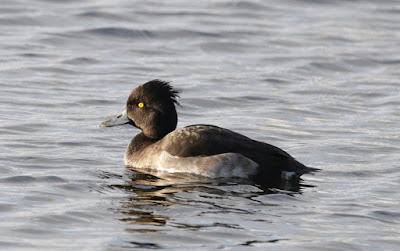The forecast of little cloud and a 4 mph wind for Thursday looked so stable that we actually confirmed our arrangement for Oakenclough on Wednesday afternoon. This is a most unusual occurrence that more often than not involves a detailed discussion around whether a ringing session is even possible in our normally unsettled weather.
I met Andy and Bryan for the 0630 start to a perfect morning of zero wind with just a little cloud together with a hint of sun peeking around the corner.
Birds were on the move from the off and the morning proved productive for both ringing and birding. Goldfinches dominated the catch but we also bagged a few warblers and more Tree Pipits to add to those of Tuesday.
Today’s catch comprised 52 birds of 10 species; in numerical order - 20 Goldfinch, 8 Chaffinch, 6 Goldcrest, 5 Willow Warbler, 4 Tree Pipit, 3 Coal Tit, 2 Blackcap, 2 Robin, 1 Great Tit, 1 Greenfinch.
The twenty Goldfinches included an adult bearing a ring immediately recognisable as not our own due the unfamiliar series of letters and numbers – S524171. Otherwise the remaining Goldfinches proved to be first years/juveniles. Almost without us trying very hard it’s looking like Goldfinch will become the most ringed bird of 2018 due simply to its abundance in town and country.
Goldfinch
All four Tree Pipits proved to be first years/juveniles. All seven we have caught this week have been first year/juveniles. This is not surprising given that by the end of the summer birds of the year will outnumber adults in the ratio of approximately 5/1 and also that adults are thought to migrate earlier than juveniles. The recovery rate for ringed Tree Pipits is actually quite low, despite ”acute persecution” in Southern France and Northern Spain (BWP).
Tree Pipit
Tree Pipit
Five Willow Warblers gave opportunities to directly compare adults (born before 2018) with first years (born 2018).
adult Willow Warbler
first year Willow Warbler
The two Blackcaps were first year birds, one female and one male.
Blackcap
We discussed how we’d not caught a Coal Tit for months and then, lo and behold, three turned up in quick succession, together with a single adult male Great Tit.
Great Tit
Not so with Blue Tits as they remain hard to come by up here – rather a strange thing to say about the most ringed bird on the BTO’s books. Our own observations and casual chatter elsewhere suggest Blue Tits may be the next to suffer from a drop in numbers.
From as early as 0700 there was a noticeable movement of Swallows overhead which tailed off about 0900 by which time we had counted 80+. As the morning warmed more Swallows arrived from the North West together with smaller numbers of House Martins as both species aerial fed in numbers approached a combined 250/300 or more.
Finches were also on the move as shown by our catch of both Goldfinches and Chaffinches with small parties of both throughout the morning. Not so with Lesser Redpoll, this has yet to appear as an autumn migrant up here.
A number of Pied Wagtails appeared in late morning with 15/20 feeding nearby and a couple or more noted flying over and due south.
Other birds noted in addition to those caught – 15 Willow Warbler, 2 Sparrowhawk, 2 Spotted Flycatcher, 2 Great-spotted Woodpecker, 1 Song Thrush, 1 Peregrine, 1 Treecreeper.
Great-spotted Woodpecker
The Spotted Flycatchers were along the nearby woodland edge of someone’s garden. These were the first I’d seen since May in Menorca where Spot Flys are ten-a-penny, unlike the UK where the species is another one in decline.
Spotted Flycatcher
The flycatchers were a good way to end an interesting and rewarding morning. And with the same forecast for Friday, who knows? We may be back for more.
Linking today to Eileen's Saturday Blogspot.




















































.jpeg)



.jpg)












